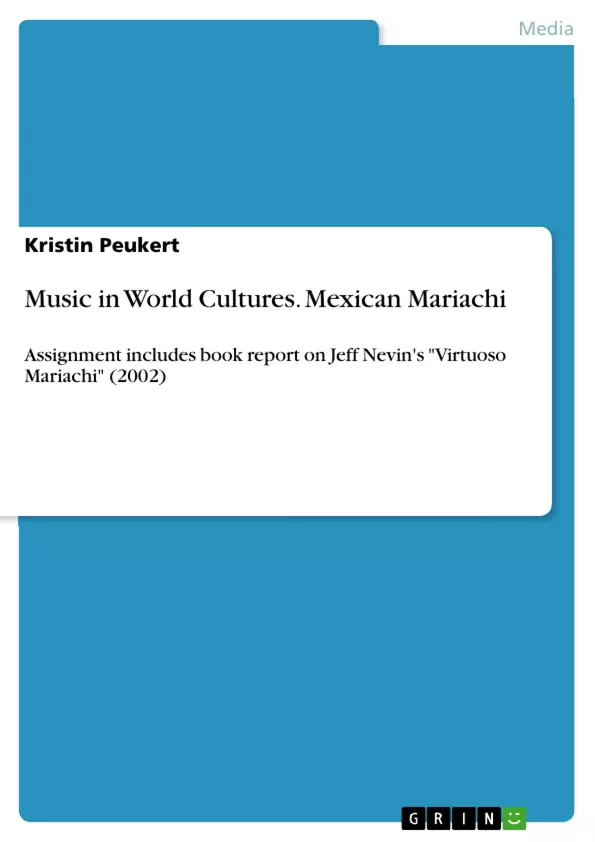Concert report on a Spanish percussion group La Banda Del Surdo from 2004.
Traditional Mexican music is a regional phenomenon and typical local instruments are characteristic for several ensembles and also important to distinguish the musical sound and the style. There are different groups from different areas.
The mariachi ensemble has its roots in Jalisco - a western state of Mexico - and is also centered in the neighbouring states like Colima, Nayarit, Michoacán and Guerrero.
The name "mariachi" refers to a Mexican musical group. The repertoire of a mariachi ensemble is known in Mexico as sones which are dances and strophic songs with refrains and a special underlying rhythm that is called "sesquialtera".
Virtuoso Mariachi: The topic of this academic book refers to the genre of Mexican mariachi including history, performance and current developments of this traditional music.
Jeff Nevin is a first-hand researcher in this field and this is his first scientific paper and the first major book considering technique and style in mariachi music, especially that of the
trumpet. He has an educational background both in music theory, composition and in performance as an arranger and classical and mariachi trumpet player as mentioned on the last page of his book.
Table of Contents
- Concert report - La Banda del Surdo (Spain)
- World musical tradition - Mexican mariachi...(+ bibliography)
- Book review on a world musical tradition - Nevin, Jeff. 2002. Virtuoso Mariachi. Lanham: University Press of America
Objectives and Key Themes
This assignment portfolio explores various aspects of world music through a concert report, a research paper on Mexican mariachi, and a book review on Mariachi music. The goal is to gain a deeper understanding of different musical traditions and their cultural significance.
- The impact of cultural influences on musical styles
- The role of percussion instruments in various world music traditions
- The use of rhythmic patterns and polyrhythms in different musical genres
- The relationship between music and dance in world cultures
- The performance aspects and audience interaction in world music concerts
Chapter Summaries
- The first chapter provides a detailed report of a live performance by the Spanish percussion group La Banda del Surdo. It highlights the group's unique blend of traditional Spanish music with influences from various world cultures, including African, Latin American, Flamenco, and Oriental rhythms. The report discusses the band's instrumentation, performance style, and interaction with the audience.
- The second chapter delves into the world musical tradition of Mexican mariachi, exploring its historical origins, instruments, and cultural significance. It examines the evolution of mariachi music and its role in Mexican society.
- The third chapter presents a review of Jeff Nevin's book "Virtuoso Mariachi," which focuses on the history and evolution of mariachi music. The review analyzes the book's arguments and insights into the tradition, its cultural significance, and its impact on Mexican music.
Keywords
This assignment portfolio focuses on key concepts such as world music, musical traditions, cultural influences, percussion instruments, polyrhythms, dance, performance, and audience interaction. It examines the specific examples of La Banda del Surdo, Mexican mariachi, and the book "Virtuoso Mariachi" to explore these concepts further.
- Citar trabajo
- Kristin Peukert (Autor), 2004, Music in World Cultures. Mexican Mariachi, Múnich, GRIN Verlag, https://www.grin.com/document/66814



